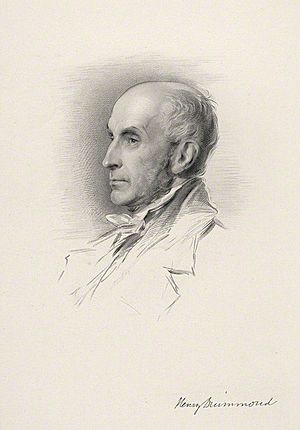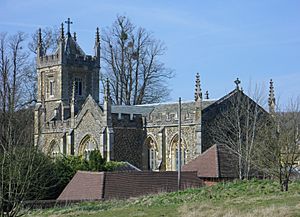Henry Drummond (1786–1860) facts for kids
Henry Drummond (born 1786, died 1860) was an English banker, politician, and writer. He is most famous for helping to start the Catholic Apostolic Church. This church is also sometimes called the Irvingite Church.
Contents
Henry Drummond's Life Story
Early Years and Education
Henry Drummond was born on December 5, 1786, in a place called The Grange, near Northington in Hampshire, England. His father, also named Henry Drummond, was a very well-known banker in London.
Young Henry went to Harrow School and then to Christ Church, Oxford University. He didn't finish his degree there. However, he left his mark on the university. In 1825, he set up a special teaching position, called a "chair," for political economy.
His Time in Politics
In 1810, Henry Drummond became a Member of Parliament (MP) for Plympton Erle. This meant he helped make laws for the country. He was very interested in almost all parts of politics from the start.
Even though he had his own strong and sometimes unusual opinions, he usually worked with the Conservative Party. His speeches were often hard to hear, but they were usually clear and full of information. Sometimes, he could be very sharp and critical. In 1826, he was chosen to be the High Sheriff of Surrey.
Starting the Catholic Apostolic Church
In 1817, Drummond met Robert Haldane in Geneva. He joined a movement that was against certain religious ideas common there at the time. Later, he became very involved with the Catholic Apostolic Church. This church was started by Edward Irving and others around 1826.
Henry Drummond hosted important meetings at his home, Albury Park, in Surrey. These meetings were called the Albury Conferences. People who shared some of Irving's ideas met there to study prophecies. Drummond gave a lot of money to the new church. He also became one of its main leaders. He was first made an "Angel" for the church in Albury. Later, he was called an "Apostle" for Scotland and parts of Switzerland. This meant he helped shape the church's beliefs along with other "Apostles" and prophets.
Later Life and Retirement
In December 1839, Henry Drummond was chosen to be a Fellow of the Royal Society. This is a special honor for people who have done important work in science. In 1843, he retired from his job as a senior partner at the Charing Cross bank.
From 1847 until he died, he continued to represent West Surrey in the parliament. He passed away in 1860 at his home, Albury Park.
Henry Drummond's Writings
Henry Drummond was very interested in religious topics. He wrote many books and pamphlets about understanding prophecy, sharing religious texts called the Apocrypha, and the main ideas of Christianity. Some of his writings defended the Catholic Apostolic Church.
In 1846, he published a book called History of Noble British Families. He also published Principles of Ecclesiastical Buildings and Ornament in 1851. This book was printed without his name on it.
A writer named Hugh McNeile dedicated his book, "The Times of The Gentiles," to Henry Drummond in 1828. In this dedication, McNeile defended Drummond from people who criticized his new ideas about understanding Bible prophecies.
His Family Life
Henry Drummond married his cousin, Lady Henrietta Hay Drummond. She was the daughter of Robert Hay-Drummond, 10th Earl of Kinnoull. They had three sons, but sadly, all of them died before their father. They also had two daughters.
Henry Drummond's Legacy
There is a street in Carlton North, Victoria, Australia, near Melbourne, that some people say was named after Henry Drummond. However, the local council believes it was named after Thomas Drummond (1797–1840). Thomas Drummond was a Scottish inventor, engineer, and mapmaker.



